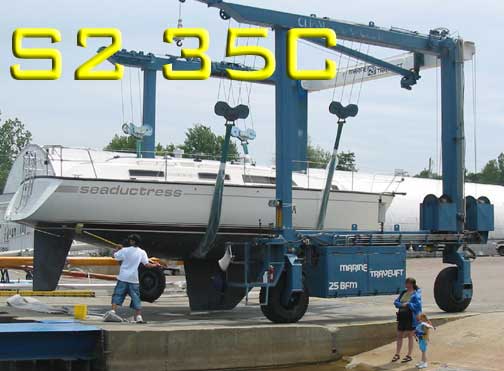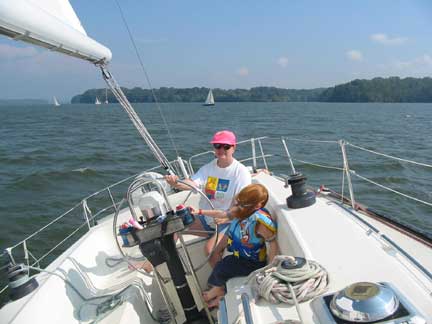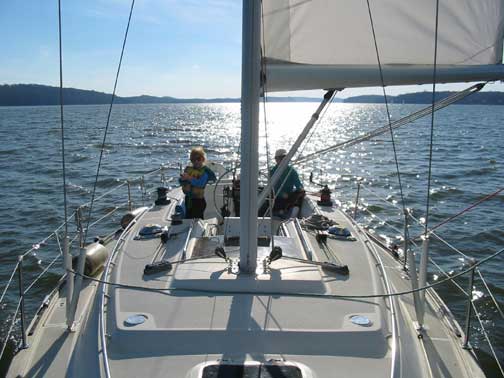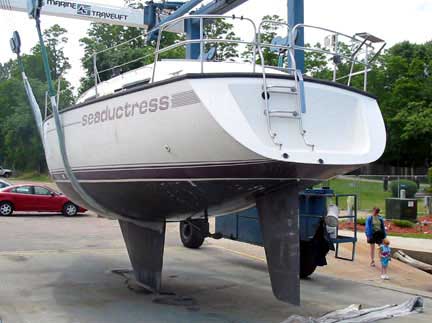
The S2-35C is a center-cockpit sloop produced by S2 Yachts from 1986-87. In many ways it is simply a refinement of the S2 11C, a 36 footer which from the drawings I have seen shares the same basic hull profile. However, there are some significant differences:
- the 11C has a solid fiberglass hull, while the 35C is balsa-cored (this is probably why the 35C weighs 1,000 pounds less)
- the 11C has encapsulated ballast (the keel is part of the hull and cannot be removed) while the 35C has a "bolt-on" fin keel.
- the 35C has a shallow "sugar scoop" transom while the 11C has a more traditional stern without a swim platform
- the 35C has a large aft locker while the 11C has none.
There were only 35 of the 35C's produced before S2 Yachts correctly predicted a downturn in the sailboat market in the late 1980's and concentrated their efforts on powerboats (which they still produce today under the Tiara name). Our 35C is hull number 32 of that 35, one of the last made. Prior to moving to Chattanooga in the summer of 2003, she lived her entire life on Lake Champlain near Burlington, Vermont. Her official name is Seaductress, but our four-year-old daughter has rechristened her Food Acres, a name which makes very little sense but has somehow stuck among our colleagues at Sale Creek Marina.

Having long envied the 35C Windborne owned by Vance Winstead and kept on Watts Bar Lake in Tennessee, Annie and I were determined to have one of our own. Including Windborne, we looked at quite a few 35Cs that happened to be for sale in the spring of 2003: LaVida, OneClub, Hilde, Bright Eyes, and Synergy. I've joked that since I've looked at eight of the 35 of these things, I might as well keep going and see them all--so if you own a 35C and wish to correspond, write me at rling@stationr.org.
Weaknesses
Love may be blind, but I've come across a few things I wish S2 had done differently on our 35C.
- The hull/deck joint is screwed rather than bolted together, perhaps to make the classy teak toerail more feasible. The genoa track, which is through-bolted, overlaps the joint for about half the distance and makes this a moot point for that portion of the boat. You've also got stanctions and cleats bolted through which add to the strength. Still, I would have preferred bolts down the entire length.
- There are no backing plates in some very obvious places, such as the cleats and bow and stern pulpits.
- Hidden under the aft locker, almost inaccessible, is a thru-hull that drains the locker. The top of the thru-hull is very close to the waterline and more likely below it when the boat is loaded. S2 used plain old plastic bilge hose to make the short connection between the bottom of the locker and the hull. If that hose fails, the boat could sink. Although you have some access to the problem from underneath the aft bunk, I installed a port in the bottom of the locker so I could then put a proper bronze thru-hull with seacock and heavier hose. It wasn't a perfect solution (now I have to worry about my access port leaking) but at least we're in no danger of sinking.
- Our 35C had no raw water strainer on the water intake for the engine.
- Like so many other production boats, our 35C relied only on sealant around the chainplates and other deck hardware to keep water from getting into the cored deck. Knowing that chainplates always leak, sooner or later, S2 should have used solid fiberglass there. As you would to make a new hole in the cored hull, I had to fillet out the coring from around the chainplate holes, fill the entire thing with epoxy, and then drill/cut the holes back open so that water might drip down into the boat but wouldn't ever touch the core.
- The wiring down the inside of the mast is enclosed in conduit, which is good, but that conduit exits from underneath the mast step. It's impossible to replace any of those wires without lifting the mast up off the step. The only alternative is to cut your own hole in the bottom of the mast above the step.

Dimensions & Specs
The numbers below (except for ballast/displacement) come from the excellent Sail Calculator Pro:
- Length/Displacement Ratio: 275 (heavy by today's standards, good for cruising)
- Sail Area to Displacement: 16.33 (moderate)
- Ballast Ratio: 43.6%
- LWL to Beam: 2.46 (moderate)
- Capsize Ratio: 1.91 (less than 2 considered relatively safe for heavy weather/offshore)
- Hull speed: 7.13 knots
- Pounds/Inch: 1,164 (weight required to sink the boat one inch).
- Motion/Comfort: 27.13 (fairly comfortable motion at sea, or at least better than some)
- Category: Cruiser
Primary fuel filter: Wix 33166
Secondary fuel filter: Wix 33358 (Fram P4102?)
Oil filter: Wix 51348 (Fram PH3614 according to an auto parts store, Malcolm Perrins says Fram PH2870A)
Fuel tank (26 gallon): 37" long, 17.5" wide, 9.75" high
Engine mounts: 24mm bolts Keel bolts: 32mm ? More engine specs in the Volvo owner's manual.
Hatches
Long opening portlights: 30" wide x 5" high
Hatches in forepeak and aft berth: 20" x 20"
Aft cabin mattress: 64" x 73" x 7"
Width of interior doorways: 14"

S2 Resources
- Loosecruise S2 Site (excellent S2 site--includes 1984 catalog)
- S2 Sailboat Owners Website: info and specs for various models.
- SailNet's S2 Discussion List: Sign up for daily e-mails from S2 enthusiasts.
- Sail Calculator (get L/D, ballest ratio, etc on any boat)
- Of course, check the menu at the upper left of this page for more of my own S2 35C pages, including the Brochure and
 Volvo 2000 Series Owner's Manual
Volvo 2000 Series Owner's Manual
- Practical Sailor has a review of the S2 11 meter in the August 1, 2002 issue.


